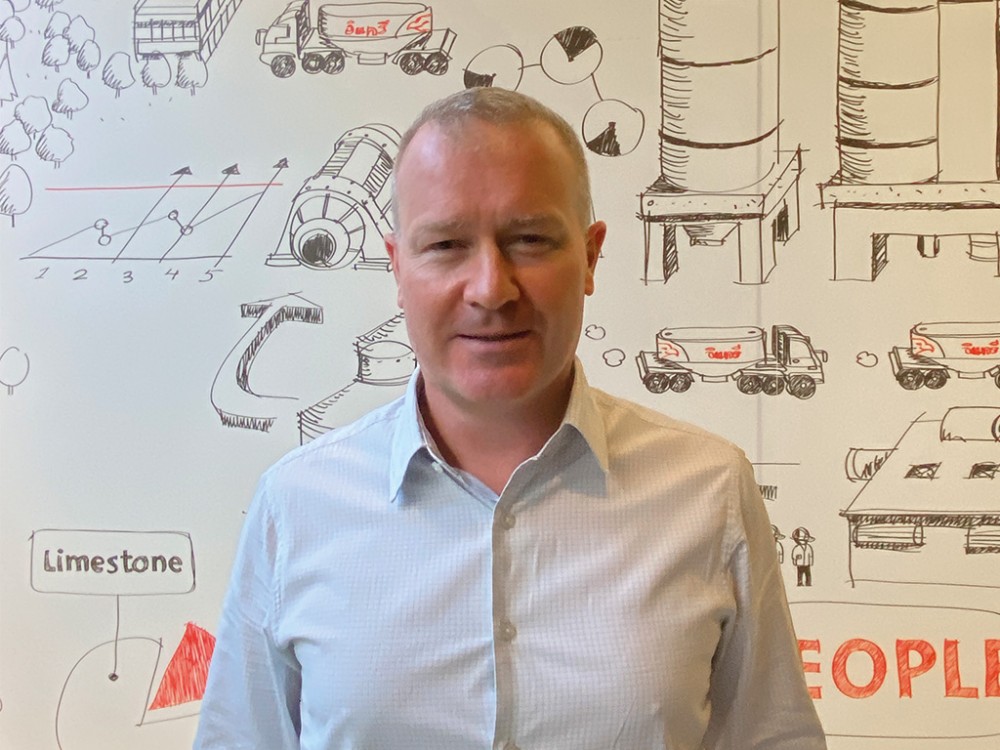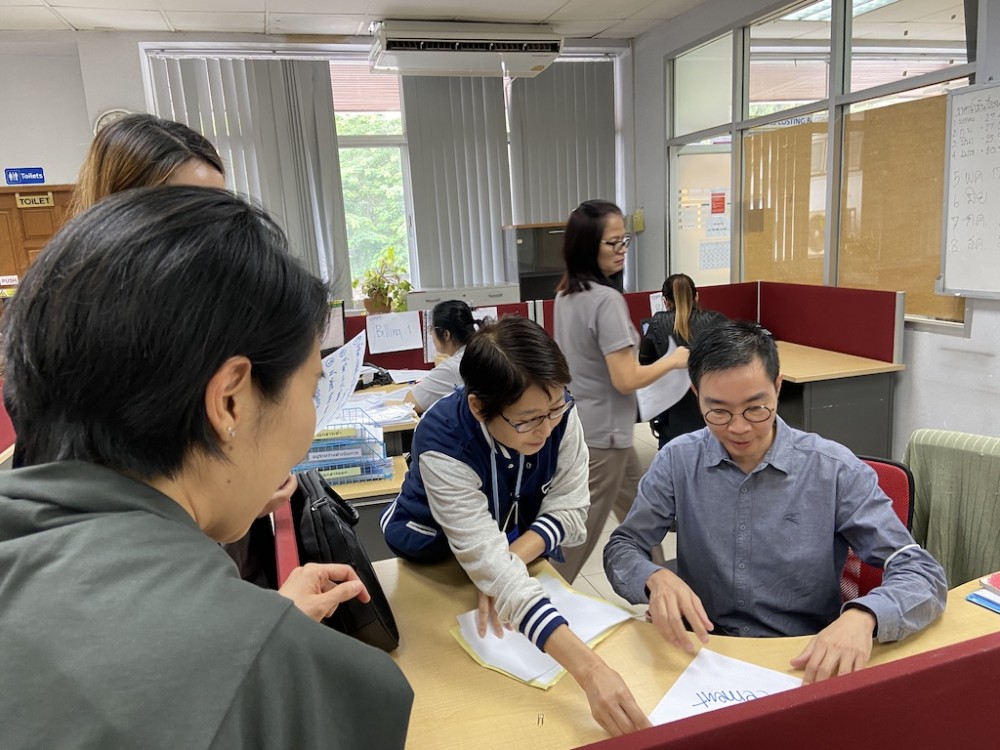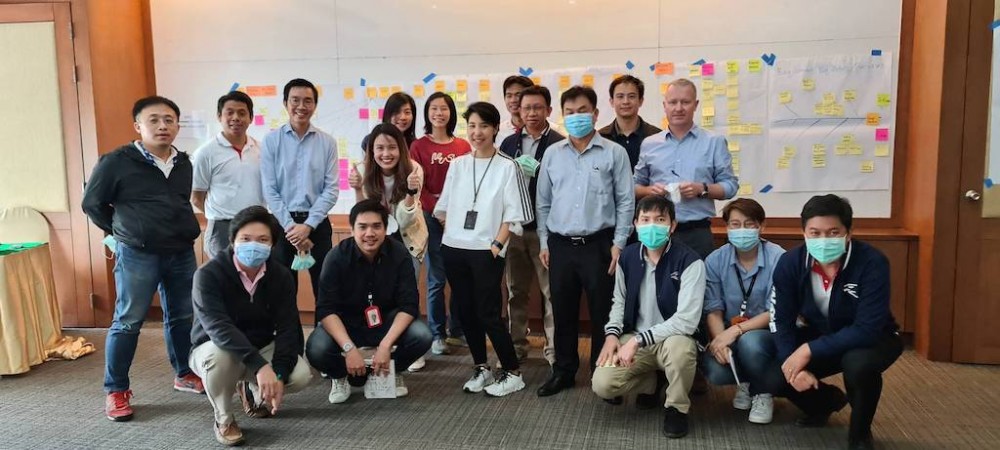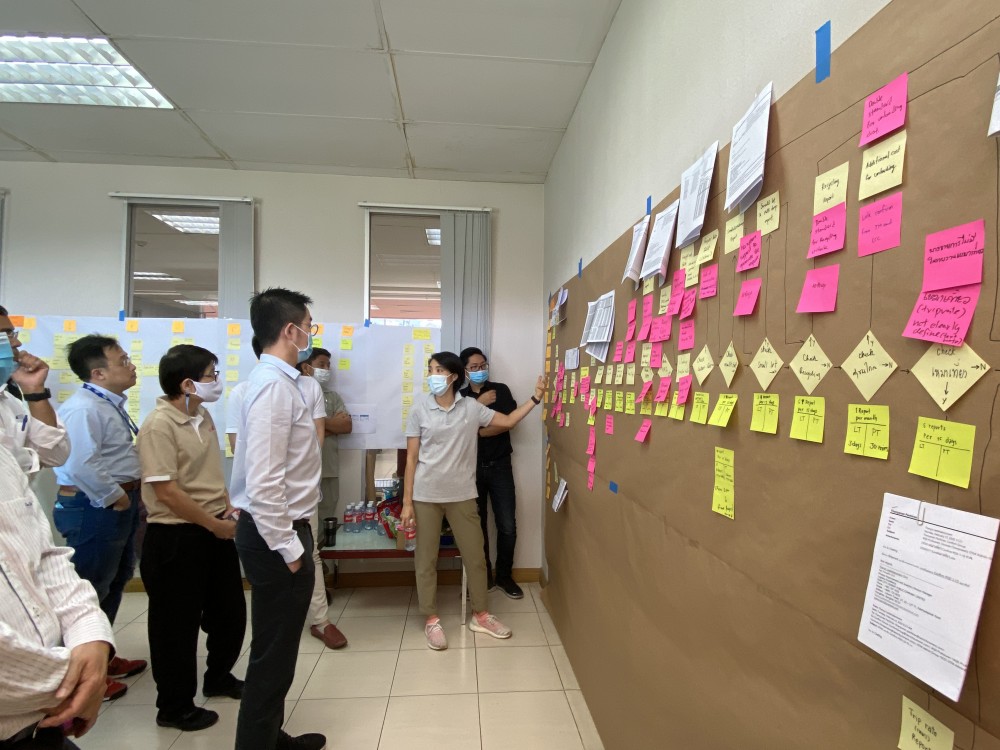Strongly believing in the value of Lean and in its effectiveness across markets and business ventures triggered Paul Hayes, Head of Supply Chain at Siam City Cement Public Company Limited Thailand (SCCC) to start a KAIZEN™ transformation for his entire team. In 2019, he decided to implement KAIZEN™ across the SCCC Supply Chain operations to become Lean and invited Kaizen Institute Thailand to accompany him on this journey. In this article, we share in-depth insights into this journey by summarizing a conversation between Ramesh Raju, Managing Partner, Kaizen Institute Thailand, and Paul, on his KAIZEN™ journey so far. Let’s start by taking a closer look at the motivation behind starting on this KAIZEN™ journey.
Improving productivity awareness in a positive and constructive way
Ramesh Raju: How did you decide to go Lean in SCCC to start with?
Paul Hayes: Interestingly, it was my past work experience with a Japanese company that gave me an overview of KAIZEN™. Based on this, I strongly believed in the potential of this philosophy. Some of us in senior management saw that Lean would be a helpful lever for change, by improving people’s awareness of productivity – in a positive and constructive way. This contrasts with the traditional approach of trying to cut costs year-on-year without serious attention to improving the ‘real’ process. Cutting costs in such a traditional way demotivates people, hence is not sustainable.
Siam City Cement Public Company Limited (SCCC): Company Profile
- Second largest cement producer in Thailand with a history of over 50 years
- An innovative supplier of cement products, services, and solutions
- Expands network to the Region including Cambodia, Bangladesh, Vietnam and Sri Lanka
- 2020: 4,734 employees; 42,000mn Baht (1,284mn USD) total net sales turnover
Sources: SCCC Company Profile; SCCC Investor Relations
What challenges did you face at the beginning?
Well, the main challenge at the beginning was to create an understanding of the full theory behind KAIZEN™. If you have not been through the experience yourself, it becomes hard to make the connection. This created some questions in the team, such as: ‘I see this concept but, what does it mean for me personally?’ ‘How does it work in daily practice?’ The only way to get beyond this is by simply starting to practice. There is no shortcut to that, it is only when you are involved in the change that your mind starts to open up and you start to see yourself.
A good example is probably our packaging team. When we began to go through the various steps, started collecting the data, and involved the operators in analysis and decision-making, various managers could not grasp the benefit of the exercise. This was particularly true of our middle management team, especially as they had been working in this area for several years and, understandably, were used to doing things in a certain way.
When things got tight, we pushed on and kept up the momentum. We understood that we had to reach a stage when things would tangibly change, when managers recognize that they are the ones that need to make changes stick. There was a lot of resistance, mainly through fear of the unknown. When production floor personnel saw that top management was behind our KAIZEN™ initiatives and that the whole emphasis was on making things better for everyone involved in the process, from beginning to end, attitudes altered dramatically. People suddenly recognized that they were now in control of their own destinies.
“The main challenge at the beginning was to create an understanding of the full theory behind KAIZEN™. If you have not been through the experience yourself, it becomes hard to make the connection.”
What kind of support did you obtain from Kaizen Institute to accompany your journey?
Kaizen Institute started by making us familiar with a little bit of theory. And then, very quickly, demonstrated how to apply this to a real situation at the workplace (gemba). This for us was a great approach, as the principles were well explained and fast understood. It was immediately clear that we would only learn by doing: the sooner the better, and being the surest way to guarantee progress.
We became very specific, as every situation is different. The KAIZEN™ guiding principles must be set within a framework that best suits each functioning group and processes. Then, in simply doing, and by focusing exclusively on the process, the benefits of the KAIZEN™ methodology become evident.
“We understood that we had to reach a stage when things would tangibly change, when managers recognize that they are the ones that need to make changes stick.”
Do you enjoy visiting your Supply Chain Gemba?
Absolutely! I am delighted because now I have a reason to go there much more often. Before I would sometimes feel guilty going to the gemba when I just got too busy. Now that it is part of our new operating philosophy, it is very important that myself and our other managers make the time to be there, at the gemba.

What made you keen to go to the Gemba?
I soon could see very clearly that daily visits to the gemba were a fundamental part of KAIZEN™ success, for that is where I could witness value being added, where muda (waste) occurs. I realized that it was not something I could see from far away. I now recognize and accept that I am not running away from my work by being at the workplace, for it is the responsibility of management to be there.
I often looked at meetings as inefficient and not adding any real value to the overall process. But when I started to see how meetings could be reframed from a KAIZEN™ perspective, everything changed because every meeting then was prepared correctly, many through stand-up discussion.
“We became very specific, as every situation is different. Then, in simply doing, and by focusing exclusively on the process, the benefits of the KAIZEN™ methodology become evident.”
How to build empowered teams in a structured approach
Siam City Cement Public Company Limited (SCCC): Strategy
Currently, the Company has determined to grow its business portfolio and expand its revenue base, and thus has expanded its businesses and established local and foreign subsidiaries and joint venture companies in Southeast Asia and South Asia. As the Company has been producing and marketing high-quality and innovative cement products domestically and in Asia, the subsidiary and associated companies were also hard at work to develop products and services related to the Company’s core business encompassing operations involving many types of construction products and fiber-cement decorative materials for architectural works both domestically and abroad. Also, well-advanced were peripheral businesses such as waste management, industrial cleaning services and international seaborne trade.
Source: SCCC Annual Report 2020
How did you introduce KAIZEN™ and Lean thinking into the organization?
When we started implementing KAIZEN™, there was some confusion and distrust, because it was not clear which tools to use and where to focus our limited resources. Following the advice of Kaizen Institute, we consistently emphasized that change is about people and transparency, especially when it comes to cross-functional processes across every activity. Data and visualizations are enablers for transparency, but the focus is on going to the gemba: ‘Go See’ where the value is added, ‘learning to see’ where muda (waste) is in the process.
When people in the organization started to see the big picture, it became quite invigorating. We made a switch from trying to squeeze more efficiency out of our existing procedures and practices, to finding a much better way of achieving more, by looking more deeply into the processes we actually have.
What have you achieved in this project already?
In 2019 we kicked off the transformation with a large pilot project which is a huge expense in our industry. It was a cross-functional project which brought together finance, planning and procurement and involved a lot of additional people ‘on the ground’. The intention was to eliminate silo-type thinking and to demonstrate full transparency every step of the way, evaluating if a KAIZEN™ approach was the future for SCCC. It opened the eyes of senior management and had a major impact on how they work together as a team, on a day-by-day basis. We had a great start, and this motivated us to do even greater things.
We then decided to implement KAIZEN™ across all functions of Supply Chain, from incoming raw materials, through packaging materials production, packing and dispatch, to outbound distribution. Within 12 months, we made very good progress in pushing ahead with our improvements. Once both managers and workers started to see the benefits of the KAIZEN™ approach, both their enthusiasm and efficiency became features of their daily performance.
Overall, our teams are now more energetic and enthusiastic than ever before. There is a real sense of achievement in our teams. The efficient flow of information and the transparency in decision making is now there for all to witness. Therefore, communications across all departments and between managers and workers have never been better.
“Overall, our teams are now more energetic and enthusiastic than ever before. There is a real sense of achievement in our teams.”
What benefits have you gained from this KAIZEN™ journey?
The first and most fundamental thing we learned from working with Kaizen Institute was that management needs to be at the workplace (gemba) as often as they can – definitely much more often than before. It is important that the managers and people at the gemba can see that senior management is taking a very serious interest in what they are doing. Our KAIZEN™ journey was one in which all of us would learn to work more closely together, thereby making us more efficient and empowering every single team.
It has to be stressed that management involvement is not about doing anyone else’s job. In contrast, everyone needs to figure out for themselves, by making their own mistakes and then applying their new knowledge to those practices in which they are involved. This is not something you can delegate.
“One very important job of senior management is to visit the workplace (gemba) regularly and to get actively involved in improvements.”
Can you elaborate a bit on the term ‘making mistakes’? What exactly do you mean by that?
It takes time to build up trust. People need to see that it is okay to mention that they do not understand what is going on, or that we do not have a solution to a particular problem, or even to raise their hands to point out a problem they have. When everyone experiences such a practice, not once but a number of times, they realize that the reactions from managers are inherently positive. This is the strength. That is a sign that their responsibility is accepted. It is a sign of the behavior we are looking for from one and all.
People now acknowledge that sharing problems in their area is what we are looking for – instead of treating it as a sign of weakness. Accepting that they have a problem is now regarded as a sign of strength, requiring all of us to work together to solve it.

Working together more closely – how is this reflected in your meeting culture?
The majority of our traditional meetings have been replaced by KAIZEN™ style meetings that include daily stand-ups at workplace team boards, especially between the shifts, as well as our daily department stand-ups and weekly Mission Control meetings at each office and plant location.
How do you see your stretch goals for 2021 and beyond?
The team feels a lot more in control of their situation, which is great. Applying KAIZEN™ to SCCC has shown us how a well-structured approach to maintaining and improving quality and process efficiency can help production and office personnel achieve significant benefits.
I am very convinced of the value of this approach as a sustainable initiative, getting everyone on the same page, making it a very collaborative, positive and invigorating way of working.
“Going to gemba and ‘learning to see’ the actual process itself, seeing the big picture- this is quite invigorating.”
Learning by doing – and realizing that something big is happening
Where does SCCC stand today in their implementation? And what are the conclusions of their KAIZEN™ journey so far? Read on to get further insights and advice on how to make such a transformation concrete.
“Learning by doing is clearly applicable to all functional groups in a business, beyond production.”
We have talked about the value of learning by doing. Can you share an example of this working in practice?
Sure – one good example was applying a pull type KANBAN approach to our finished packaging materials inventories that were used to push type production planning. Having explained the philosophy and approach, we started with one Stock Keeping Unit (SKU). While implementation could have been fast, we decided to let the teams find their own way, at their own speed. Kaizen Institute initially guided our production team with one SKU – after that, they successfully managed another SKU on their own in three weeks. That allowed them to get used to the concept and make the necessary adjustments to be able to take on the remaining SKUs.
Siam City Cement Public Company Limited (SCCC): Commitments
Working as a team
One group, one vision, one team united in heart with our business partners for the good of all
Doing what is right
Staying true to ourselves and each other, maintaining the highest standards of discipline and integrity in everything we say and do.
Challenging conventions
We are imaginative and always open to new ideas. We approach every business challenge with enthusiasm and strive to deliver innovative solutions beyond expectations.
Caring about our future
We are committed to creating a positive future for generations to come. Caring for our people, our environment, our community, our nation.
Source: SCCC Annual Report 2020
Do you think learning by doing can be applied in an office environment?
It is clearly applicable to all functional groups in a business, beyond production. It is of course more easily understood in a production environment, since you are dealing with physical things. For example, within our offices, we successfully applied it to our accounts payable and supply chain costing processes. Our office team worked through it themselves, identifying waste in their processes, proposing solutions and implementing them along the way.
What takeaways did your cross functional teams come up with?
When other SCCC functions looked at the supply chain they were able to see obviously that something big was happening and they needed to make the change as well.
One example I have in my mind is when a Vice President from another function spent some time with us, walking around and looking and hearing what was happening. He told me he could sense there was something important going on, just by the energy of the people and their openness and enthusiasm at all levels. An overwhelming amount of positive vibes from everyone, he said.
“The new way of working is about looking for Continuous Improvement. We do it because we would not even consider going back to the traditional way of doing projects.”
Can you share your key conclusions on transitioning to a KAIZEN™ way of working.
The KAIZEN™ way centers around the importance of examining a process in great detail, focusing on problem areas, the pain points. This means involving people that actually do the work, your production or office personnel. When we bring in external consultants, they come with detailed reports of what the problems are and what it should be. We need to accept that change does not come overnight, but simply by steady and orderly application of a methodology that targets small improvements one at a time by involving people at every level.
These small steps can have a major impact on company efficiency and profitability. We found a way to take the people on that journey and coach them through that. Not everyone will progress at the same speed. Yet, once a team is in place that understands the principles, be prepared to witness some outstanding improvements. It is important to recognize that no process is perfect. Hence, future changes will inevitably be required to keep up with technology and/or the competition. What is important is to have a business structure that operates the KAIZEN™ way, the structured and analytic way, if the goal is to maximize operational efficiency within a supportive environment.
“The KAIZEN™ way centers around the importance of examining a process in great detail, focusing on problem areas, the pain points. This means involving people that actually do the work.”
Now that you have solved the most urgent challenges – is it time to relax?
No, definitely not. The new way of working is about looking for Continuous Improvement; how can we do things better? This new way of working for me and for everybody involved is not like a traditional project that we need to implement because someone wants to roll it out. Instead, we do it because we would not even consider going back to the traditional way of doing things.

What advice would you give to leaders’ contemplating a KAIZEN™ journey?
Be prepared to accept that it is an involving and relatively long-term journey, far beyond being ‘the flavor of the month’. Company management needs to realize that it is not only about a long-term commitment, but also about one that will change the detailed way the business operates. It is also an ongoing process, since there are always improvements that can be made to any company process at any time. A KAIZEN™ journey must be your main show in town, if you truly want to reap the benefits it has to offer, both now and in the future.
